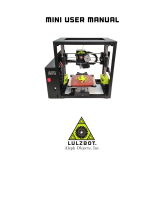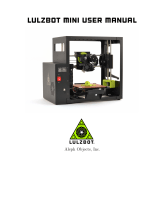
1. Introduction
UP! mini 3D Printer User Manual 2
1. INTRODUCTION ................................................................................................................... 3
1.1 HOW TO USE THIS MANUAL .................................................................................................. 3
1.2PRECAUTIONS ..................................................................................................................... 3
1.2.1 Safety ........................................................................................................................ 3
1.2.2 Protection .................................................................................................................. 4
2. OVERVIEW ........................................................................................................................... 5
2.1 APPEARANCE ..................................................................................................................... 5
2.2 SPECIFICATIONS ................................................................................................................. 8
2.2.1 Printer Physical Characteristics ................................................................................ 8
2.2.2 Specifications ............................................................................................................ 8
2.2.3 Environmental specifications .................................................................................... 9
3. OPERATION ........................................................................................................................ 10
3.1 PREPARATION .................................................................................................................. 10
3.1.1Installation the printer ............................................................................................... 10
3.1.2 Installing the software ............................................................................................. 13
3.1.3 Installing drivers ...................................................................................................... 14
3.2 USING THE BASIC FUNCTIONS ............................................................................................ 16
3.2.1 Start the program .................................................................................................... 16
3.2.2 Loading a 3D model ................................................................................................ 16
3.2.3View Options ............................................................................................................ 19
3.2.4 Model transformations ............................................................................................ 20
3.2.5 Placing models onto the build platform ................................................................... 22
3.3 GETTING READY TO PRINT ................................................................................................ 23
3.3.1 Initializing the Printer ............................................................................................... 23
3.3.2 Calibrating the Nozzle Height ................................................................................. 24
3.3.3
3.3.4 Other Maintenance Options .................................................................................... 28
3.3.5 Preparing the Platform ..................................................................
错误
!
未定义书签。
4. PRINTING ............................................................................................................................ 39
5. MODEL REMOVAL ............................................................................................................. 43
6. MAINTENANCE .................................................................................................................. 47
6.1 CHANGING THE MATERIAL ................................................................................................. 47
6.2 VERTICAL CALIBRATION .................................................................................................... 48
6.3 CLEANING THE NOZZLE ..................................................................................................... 50
6.4 REMOVING /CHANGING THE NOZZLE .................................................................................. 51
6.5 LUBRICATION OF BEARINGS ..................................................................... 错误!未定义书签。
6.6 SPARE PARTS ................................................................................................................... 51
7. TIPS & TRICKS ................................................................................................................... 52
8. TROUBLESHOOTING ........................................................................................................ 53
SOLUTION FOR "WINUSB.DLL NOT FOUND" PROBLEM ................................................................ 53
























